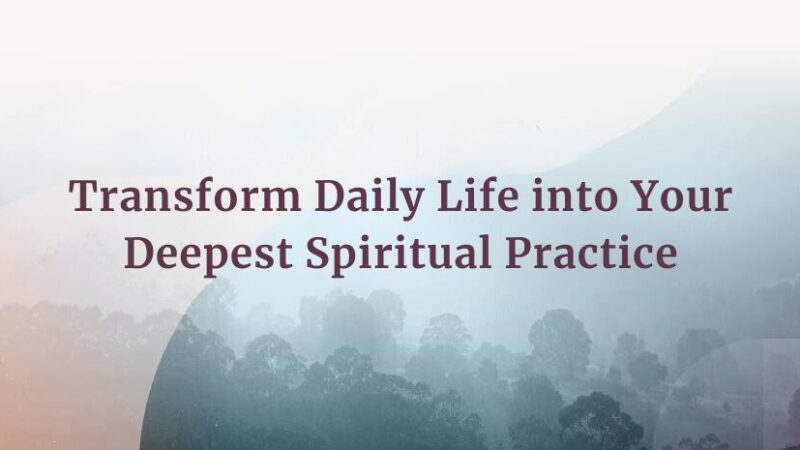I was speaking with my friend and Sounds True author Tara Brach a few weeks ago about the many ways spirituality can serve a defensive function, resulting in the avoidance of unresolved emotional wounding. During our conversation Tara used a phrase “premature forgiveness,” where she was pointing to how in the rush to do the right spiritual thing – sending love, kindness, compassion, or forgiveness to a person who has deeply hurt us – we can act prematurely, before we’re ready to do so in a deeply embodied way. We to want to replace our yucky feelings of aggression, anger, and hatred with those noble qualities of love, kindness, and understanding. We want to transform the negative into the positive. This is so natural, of course. None of us want to hold these darker energies in our hearts, in our psyches, and in our bodies.
But when we move straight to forgiveness, compassion, or kindness, without first metabolizing those feelings of hurt, shame, pain, and grief which are inside us, perhaps we shortcut the unfolding of love. When we are able to first digest the deep hurt we have felt, resisting the temptation to transcend it or even heal it, we cut into a lifetime’s organization of turning from immediate, embodied experience. We see that we can begin to make a commitment to becoming deeply intimate with all parts of ourselves that seek our attention, holding them closely as guests of our hearts, as potential messengers from beyond. We do not need to ostracize our pain, orphan it, and send it away as part of our spiritual journey, for all is welcome here. There is no timeline, but only the one that our own hearts reveal. We can discover that what we are is an open, luminous, holding environment of awareness, a capacity to allow ourselves to be touched and transformed by whatever appears. It is not always easy, rarely fun, oftentimes terrifying; but we might come to see that by meeting these energies directly, they are able to show us the way Home; that, in fact, at the core of every emotion, every sensation, and every feeling that could ever be is the substance of love itself, the nature of awakened consciousness.
 This energy or movement of forgiveness, which is of course an important and noble one, has a way of arising naturally, on its own, when our pain, grief, and hurt is metabolized in our hearts and bodies, when we allow it to be touched by the light of our awareness. In this sense, forgiveness is not so much a “practice” that we do or even the result of an intention that we’ve made; it lives and breathes and moves outside of the conceptual world entirely. We see that it is a somatic process, one that is effortless in a sense. As our pain and grief is processed, in a deeply embodied way, according to a timeline that is unique to each human heart heart, forgiveness may naturally be there waiting for us on the other side. Forgiveness, then, may not be something that we “do,” or try to do, and is no longer seen as evidence that we are a “spiritual” person and so forth. Many people that I speak with have concluded that they have “failed” because they have not forgiven, they feel shame that they are not good spiritual practitioners, that somehow the mere presence of sensations and feelings such as anger or rage or grief indicate that they are lost, unspiritual, and unworthy of love.
This energy or movement of forgiveness, which is of course an important and noble one, has a way of arising naturally, on its own, when our pain, grief, and hurt is metabolized in our hearts and bodies, when we allow it to be touched by the light of our awareness. In this sense, forgiveness is not so much a “practice” that we do or even the result of an intention that we’ve made; it lives and breathes and moves outside of the conceptual world entirely. We see that it is a somatic process, one that is effortless in a sense. As our pain and grief is processed, in a deeply embodied way, according to a timeline that is unique to each human heart heart, forgiveness may naturally be there waiting for us on the other side. Forgiveness, then, may not be something that we “do,” or try to do, and is no longer seen as evidence that we are a “spiritual” person and so forth. Many people that I speak with have concluded that they have “failed” because they have not forgiven, they feel shame that they are not good spiritual practitioners, that somehow the mere presence of sensations and feelings such as anger or rage or grief indicate that they are lost, unspiritual, and unworthy of love.
Forgiveness is not something we need to take on as a project. We come to see that there are times when forgiveness is not actually the energy that is being called forth in a particular situation and may not be the most skillful or, ultimately, the most loving or the most kind. It is very important to explore this. Setting boundaries, taking space, honoring the call of the body, listening to the heart, being angry – the total mandala of our situation may be calling for a different response. This call can be acknowledged and honored, and in this way these other responses can be just as “spiritual” as forgiveness; in actuality, more so, especially if the forgiveness is “premature.” It is possible the anger that is there, the shame, the hurt, the embarrassment, the jealousy, the grief, the terror, the fear – that these feelings, sensations, and qualities are inviting us to explore them deeply, to touch them, to hold them, to allow them all the way in; to honor them. Often, in our rush to forgive them away, to be good spiritual people, we lose touch with their essence, intelligence, and the gifts they may have to offer, thereby losing touch with our own hearts.
For those of you who are interested in the areas of self-compassion, working with shame, self-acceptance, and self-love, I really recommend Tara’s work for those who may not be familiar with it. Her audio programs – Radical Self-Acceptance, Finding True Refuge, and Meditations for Emotional Healing – are important and ones I recommend often. I’m really happy to note that Tara will be joining us at this year’s Wake Up Festival!


 This energy or movement of forgiveness, which is of course an important and noble one, has a way of arising naturally, on its own, when our pain, grief, and hurt is metabolized in our hearts and bodies, when we allow it to be touched by the light of our awareness. In this sense, forgiveness is not so much a “practice” that we do or even the result of an intention that we’ve made; it lives and breathes and moves outside of the conceptual world entirely. We see that it is a somatic process, one that is effortless in a sense. As our pain and grief is processed, in a deeply embodied way, according to a timeline that is unique to each human heart heart, forgiveness may naturally be there waiting for us on the other side. Forgiveness, then, may not be something that we “do,” or try to do, and is no longer seen as evidence that we are a “spiritual” person and so forth. Many people that I speak with have concluded that they have “failed” because they have not forgiven, they feel shame that they are not good spiritual practitioners, that somehow the mere presence of sensations and feelings such as anger or rage or grief indicate that they are lost, unspiritual, and unworthy of love.
This energy or movement of forgiveness, which is of course an important and noble one, has a way of arising naturally, on its own, when our pain, grief, and hurt is metabolized in our hearts and bodies, when we allow it to be touched by the light of our awareness. In this sense, forgiveness is not so much a “practice” that we do or even the result of an intention that we’ve made; it lives and breathes and moves outside of the conceptual world entirely. We see that it is a somatic process, one that is effortless in a sense. As our pain and grief is processed, in a deeply embodied way, according to a timeline that is unique to each human heart heart, forgiveness may naturally be there waiting for us on the other side. Forgiveness, then, may not be something that we “do,” or try to do, and is no longer seen as evidence that we are a “spiritual” person and so forth. Many people that I speak with have concluded that they have “failed” because they have not forgiven, they feel shame that they are not good spiritual practitioners, that somehow the mere presence of sensations and feelings such as anger or rage or grief indicate that they are lost, unspiritual, and unworthy of love.


